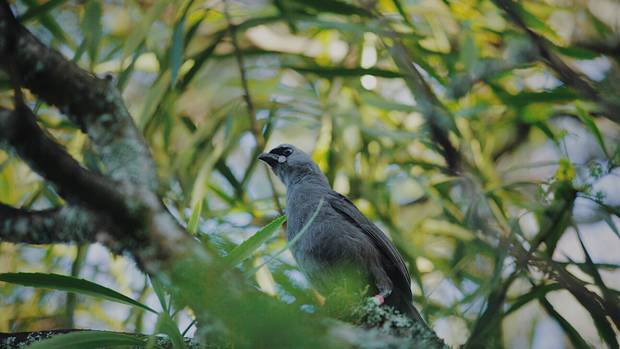
Kōkako are nesting on the mountain for the first time in decades, with all four monitored pairs in the management area hatching chicks this season.
Outside the monitored area, however, not everything is going to plan.
There is a first-of-its-kind coupling of two male kōkako.
The pair are described as "very much in love" and are displaying typical courtship behaviour — bringing each other food and singing duets.
They have been observed by ecologist Dave Bryden, who works for the Pirongia Te Aroaro o Kahu Restoration Society.
The award-winning society is responsible for returning the native bird to the mountain after the last kōkako died out in Pirongia in the 1990s.
Dave says the male birds reside near a mountain peak called Tihitoetoe.
"Male-male kōkako pairs can build nests but they obviously won't lay any eggs," Dave says.
"The nests built by male-male pairing are typically structurally sound, but lacking the interior design touches such as a lining of moss and soft ponga filaments that a female would adorn her nest with."
Dave says male-male pairings were common before intensive mammalian pest control was implemented across kōkako populations.
"This was because of a male bias in populations, as female kōkako do all of the incubation and brooding duties, and as such, are more vulnerable to being preyed upon by stoats and possums."
Pirongia Te Aroaro o Kahu Restoration Society chairwoman Clare St Pierre says the male birds live in an area of the mountain where there are no female kōkako.
"Male-male pairs aren't unheard of and it usually indicates no females around," Clare says.
She says the birds were translocated to the mountain with existing female partners.
"We released roughly half males and half females, but these birds are on their own south of our pest control area.
"We're not expecting it to be permanent as both birds have had previous female pairs and have displayed heterosexual interest in the past. It can be a long or temporary pair bond — perhaps they are just waiting for suitable females."
Clare hopes the birds will find female counterparts in order to maximise breeding and grow the kōkako population.
"But we have to accept what eventuates with any pairing and we love our kōkako all the same."
Of the four male-female pairs so far established in the managed area, each have successfully fledged chicks, and three of the four pairs are now re-nesting.
The nests are being monitored by a team of volunteers.
Last year 14 kōkako with Pirongia lineage were returned to the mountain — another step towards the society's goal to re-establish a self-sustaining population.
So far, 23 males and 21 females have been released.











